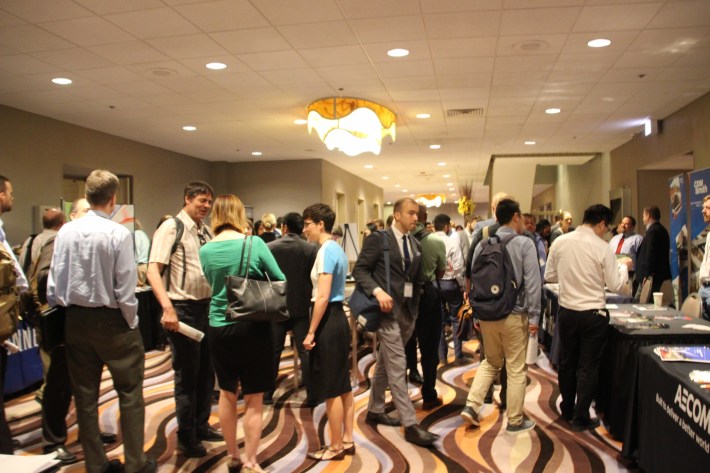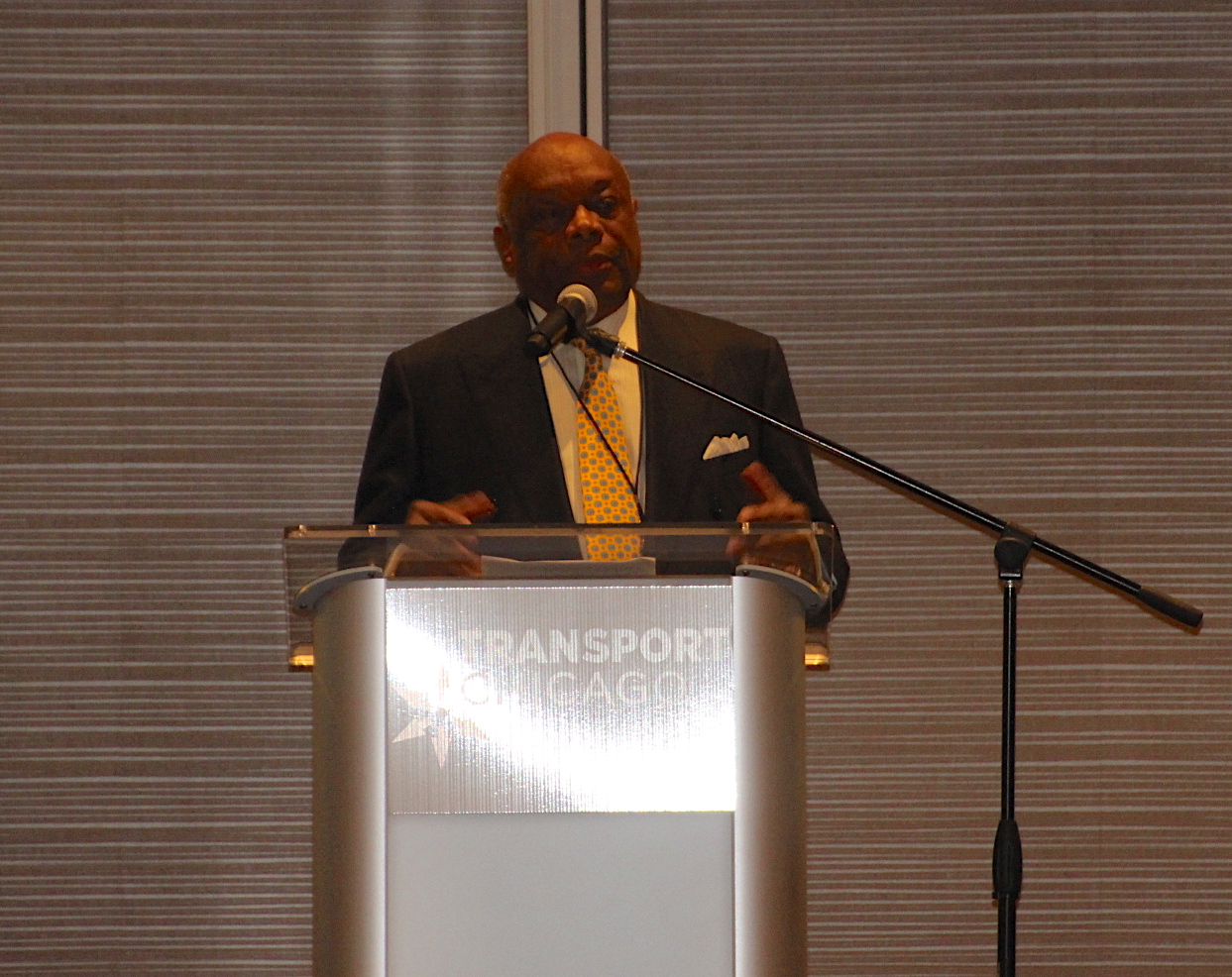The Transport Chicago Conference is an annual event held in Chicago for researchers, practitioners and policy makers to meet and exchange ideas and best practices based on trends around the world. The event was first held in 1986 as the Metropolitan Conference on Public Transportation Research. Over time the conference has grown to include a larger number of presentations, as well as a greater focus on diverse modes of transportation and diverse settings. In 2000, the present name of Transport Chicago Conference was adopted to better reflect the expansion of topics.
The 2017 conference was held last at the Holiday Inn Chicago Mart Plaza. The primary sponsor was Cubic Transportation Systems, a designer of transportation payment and information systems such as Ventra, the transit fare payment system for the Regional Transportation Authority (RTA) of Chicago. The keynote speakers were former Mayor of San Francisco Willie Brown, Jr. and Charles Marohn, the founder of Strong Towns, a Minnesota based urban planning website, news blog and podcast about creating a movement of change in urban planning, with a focus on cities. The conference also included three breakout sessions, poster sessions and a riverwalk tour, offering many learning opportunities for attendees.
Brown served as Mayor of San Francisco from 1996 to 2004. His biggest accomplishments included rebuilding the San Francisco Municipal Transportation Agency system and using bond measures to develop affordable housing. Today he leads the Willie L. Brown, Jr., Institute on Politics and Public Service. In his speech, he discussed the importance of transportation as a political means to reach voters and to help citizens. He also stated the importance of what he calls “Total Planning” where every department works together comprehensively to plan and build a system that successfully moves goods and people. He said that “It’s not just knowing the transit system layout and schedules, but knowing how the system works and interacts with other modes of transit.”
The first breakout session had four choices: F^3: Flexible Future Fleets, Power to the People, Public Private Partnerships (P3) Doesn’t Mean Free, and New Directions in Transportation Equity. I attended the Power to the People seminar which discussed three projects to improve public transit and Transit Oriented Development through public engagement and stakeholder outreach. The speakers were Lauren Day of the Indianapolis Public Transportation Corporation (IndyGo), David Wright of the Gary Public Transportation Corporation (GPTC), James Considine of engineering consultation firm T.Y. Lin, Steve Hands of the Chicago Transit Authority and Teresa Fourcher of the architecture and planning firm Solomon Cordwell Buenz.

Lauren Day gave a presentation called Mass Transit Means: The Advocacy Coalition + Public Agency Execution a Successful Referendum about passing a transit funding referendum in Marion County, Indiana by 60 percent of the vote to improve bus service in Indianapolis. David Wright and James Considine gave a joint presentation called Towards a More Complete Corridor: 'Livable Broadway' and the Multimodal Transit Plan. They discussed how to improve Northwest Indiana bus transit and development along Broadway (Indiana State Road 53) between the Gary Metro Center (South Shore Line) at 4th Street in Gary and US Highway 231 in Crown Point. Steve Hands and Teresa Fourcher gave a presentation called Transit Agencies and Community Planning - Case Study in Supporting TOD with the Chicago Transit Authority on TOD development along the north side of Chicago as part of the Red Purple Modernization Project to rebuild the stations between Lawrence & Bryn Mawr on the Red Line and to build a flyover track at Belmont to improve efficiency.
The second breakout session had four choices: Mr. Roger’s Neighborhood Plan, They See Me Roadin’, All For One; One For All, and Rivers Run Through It. I attended All For One, which discussed a project to improve public transit access for people with disabilities, a data driven study assessing transit usage for people with disabilities and a presentation on trends in biking and walking around Chicagoland. The speakers were Lindsay Bailey of the Chicago Metropolitan Agency for Planning (CMAP), Sonali Tandon and Amy Serpe of the CTA, and C. Scott Smith of the Transportation Research Institute for Livable Communities at Western Michigan University.
Bailey presented on Regional Trends in Walking and Biking. Her presentation discussed how increases in biking and walking require increased safety measures and infrastructure to make these non-motorized modes of transportation more comfortable and convenient. Sonali Tandon and Amy Serpe held a joint presentation called Accessibility at the CTA – Present and Future. Their presentation discussed how the CTA has created a plan called All Stations Accessible Plan (ASAP) to make every rail station ADA accessible to people with disabilities over the next 20 years. Scott Smith presentation was called Estimating and Enhancing Public Transit Accessibility for People with Mobility Limitations: A Kalamazoo County, Michigan Case Study Using GTFS data. It discussed how to use the General Transit Feed System (GTFS) to study transit services and patterns in Kalamazoo County, Michigan to help prioritize access for people with disabilities.
Marohn, a professional engineer and urban planning expert, spoke over lunch. He is a member of the American Institute of Certified Planners (AICP), as well as the author of Thoughts on Building Strong Towns and A World Class Transportation System. His mission is to support models of change in development that help American towns and cities become financially strong and resilient. He spoke about why so many cities and towns across America are struggling financially. Reasons cited include deteriorating infrastructure, unsustainable growth and government debt. He talked about the rise of suburbia over the past 50 years and how we are building farther and farther out in terms of roads, housing and retail without looking at the long term picture in terms of sustainability and financial return. He said that “We have built out too far and too fast with short term financial incentives and long term financial obligations. We should be making small incremental investments rather than large transformative projects.” This will change how we develop our communities to look at the long term financial and environmental costs.
The third and final breakout session had four choices: Planning The Last Mile: Lessons from DuPage County, Roll Models, eTOD: Making Transit Oriented Development Great (Again); and Ask The Decision Makers. I attended Planning The Last Mile, which discussed multiple partnerships between Pace Suburban Bus (Pace), DuPage County and the Regional Transportation Authority (RTA) to improve transit services and to fix "last mile gaps" between public transit and large corporate destinations within DuPage County. The speakers were John Loper of the DuPage County Division of Transportation (DuDOT), Matthew Stegeman of Pace, and Peter Fahrenwald of the RTA. They each discussed their ideas to improve Pace bus and vanpool services in order to help bridge the gap between public transit (e.g. a Metra Station or fixed bus route) and business destinations for workers in that area.
The Transport Chicago conference was a great opportunity to get updates on the latest transportation development and learn about best practices. I definitely recommend checking it out next year if you can.








